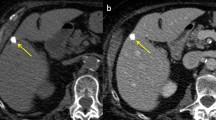Abstract
Introduction
The relative roles of magnetic resonance cholangiopancreatography (MRCP) and endoscopic ultrasound (EUS) in the investigation of common bile duct (CD) calculi were evaluated using “evidence-based practice” (EBP) methods.
Methods
A focused clinical question was constructed. A structured search of primary and secondary evidence was performed. Retrieved studies were appraised for validity, strength and level of evidence (Oxford/CEBM scale: 1–5). Retrieved literature was divided into group A; MRCP slice thickness ≥5 mm, group B; MRCP slice thickness = 3 mm or 3D-MRCP sequences.
Results
Six studies were eligible for inclusion (3 = level 1b, 3 = level 3b). Group A: sensitivity and specificity of MRCP and EUS were (40%, 96%) and (80%, 95%), respectively. Group B: sensitivity and specificity of MRCP and EUS were (87%, 95%) and (90%, 99%), respectively.
Conclusion
MRCP should be the first-line investigation for CD calculi and EUS should be performed when MRCP is negative in patients with moderate or high pre-test probability.



Similar content being viewed by others
References
Staunton M (2007) Evidence-based radiology: steps 1 and 2-asking answerable questions and searching for evidence. Radiology 242:23–31
Haynes RB (2001) Of studies, summaries, synopses, and systems: the “4S” evolution of services for finding current best evidence. Evid Based Ment Health 4:37–39
The Cochrane Collaboration (2007) http://www.cochrane.org. Accessed: 5 May 2007
National Health Service (NHS) (2007) National Institute for Clinical Excellence http://www.nice.org.uk. Accessed: 5 May 2007
Clinical Evidence (2007) http://www.clinicalevidence.com. Accessed: 5 May 2007
National Library of Medicine (2007) http://www.ncbi.nlm.nih.gov/PubMed/. Accessed: 5 May 2007
Dodd JD, MacEneaney PM, Malone DE (2004) Evidence-based radiology: how to quickly assess the validity and strength of publications in the diagnostic radiology literature. Eur Radiol 14:915–922
Scheiman JM, Carlos RC, Barnett JL, Elta GH, Nostrant TT, Chey WD, Francis IR, Nandi PS (2001) Can endoscopic ultrasound or magnetic resonance cholangiopancreatography replace ERCP in patients with suspected biliary disease? A prospective trial and cost analysis. Am J Gastroenterol 96:2900–2904
de Ledinghen V, Lecesne R, Raymond JM, Gense V, Amouretti M, Drouillard J, Couzigou P, Silvain C (1999) Diagnosis of choledocholithiasis: EUS or magnetic resonance cholangiography? A prospective controlled study. Gastrointest Endosc 49:26–31
Ainsworth AP, Rafaelsen SR, Wamberg PA, Durup J, Pless TK, Mortensen MB (2003) Is there a difference in diagnostic accuracy and clinical impact between endoscopic ultrasonography and magnetic resonance cholangiopancreatography? Endoscopy 35:1029–1032
Materne R, Van Beers BE, Gigot JF, Jamart J, Geubel A, Pringot J, Deprez P (2000) Extrahepatic biliary obstruction: magnetic resonance imaging compared with endoscopic ultrasonography. Endoscopy 32:3–9
Aube C, Delorme B, Yzet T, Burtin P, Lebigot J, Pessaux P, Gondry-Jouet C, Boyer J, Caron C (2005) MR cholangiopancreatography versus endoscopic sonography in suspected common bile duct lithiasis: a prospective, comparative study. AJR Am J Roentgenol 184:55–62
Kondo S, Isayama H, Akahane M, Toda N, Sasahira N, Nakai Y, Yamamoto N, Hirano K, Komatsu Y, Tada M, Yoshida H, Kawabe T, Ohtomo K, Omata M (2005) Detection of common bile duct stones: comparison between endoscopic ultrasonography, magnetic resonance cholangiography, and helical-computed-tomographic cholangiography. Eur J Radiol 54:271–275
Schmidt S, Chevallier P, Novellas S, Gelsi E, Vanbiervliet G, Tran A, Schnyder P, Bruneton JN (2007) Choledocholithiasis: repetitive thick-slab single-shot projection magnetic resonance cholangiopancreaticography versus endoscopic ultrasonography. Eur Radiol 17:241–250
Levels of Evidence (2007) Oxford Centre for Evidence Based Medicine http://www.cebm.net/levels_of_evidence.asp. Accessed: 5 May 2007
Dodd JD (2007) Evidence-based practice in radiology: steps 3 and 4-appraise and apply diagnostic radiology literature. Radiology 242:342–354
MacEneaney PM, Malone DE (2000) The meaning of diagnostic test results: a spreadsheet for swift data analysis. Clin Radiol 55:227–235
Verma D, Kapadia A, Eisen GM, Adler DG. (2006) EUS vs MRCP for detection of choledocholithiasis. Gastrointest Endosc 64:248–254
Acknowledgments
The author would like to thank Dr R. Gibney for highlighting this important clinical question to the group and in assisting in formulation of the structured clinical questions used to search the literature and Dr. D. Malone for his assistance with project completion and manuscript preparation.
Author information
Authors and Affiliations
Corresponding author
Additional information
C. J. McMahon is a fifth year trainee (Fellow) in the programme of the Faculty of Radiologists, Royal College of Surgeons in Ireland and learned EBP techniques in the St Vincent’s University Hospital EBP group.
Rights and permissions
About this article
Cite this article
McMahon, C.J. The relative roles of magnetic resonance cholangiopancreatography (MRCP) and endoscopic ultrasound in diagnosis of common bile duct calculi: a critically appraised topic. Abdom Imaging 33, 6–9 (2008). https://doi.org/10.1007/s00261-007-9304-3
Published:
Issue Date:
DOI: https://doi.org/10.1007/s00261-007-9304-3




